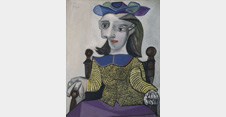Bereichsnavigation
Charlottenburg
In the years when Germany was divided, Charlottenburg was the home primarily for the Foundation’s archaeological collections. Since 1996, with the addition of the Museum Berggruen, and later with the Sammlung Scharf-Gerstenberg, a museum district for High Modernist art was established. The Museum für Fotografie is also in Charlottenburg.
The Charlottenburg Museum District in the Foundation’s Early Years
When the Foundation began work in 1961, various spaces, some of them leased, were available to it in the Charlottenburg District of West Berlin. The Nationalgalerie’s collection was shown in the Orangerie of Schloss Charlottenburg (Charlottenburg Palace). The Museum für Vor- und Frühgeschichte (Museum of Prehistory and Early History) found its place in the Langhansbau, which was also part of the palace. Until it was moved to Dahlem 1964, the Sculpture Gallery was also there. In the Knobelsdorff wing of the palace, the Kunstgewerbemuseum (Museum of Decorative Arts) opened in 1963. Beginning in 1986, that wing also housed the Nationalgalerie’s Galerie der Romantik (Gallery of Romanticism).
In the immediate vicinity of Schloss Charlottenburg, two barracks designed by Friedrich August Stüler were available for the Foundation to use. In 1960 the Antikensammlung (Collection of Classical Antiquities) moved into the west Stülerbau. In 1967 the Ägyptisches Museum (Egyptian Museum) opened in the east Stülerbau. A little more than ten years later, the latter was expanded to include the Marstallgebäude. The Landwehrkasino on Jebensstrasse, the present location of the Museum für Fotografie housed the Kunstbibliothek (Art Library) as well as storage and workshops for several museums.
Moving Collections Alters the Identity of the Location
In 1994 the Kunstgewerbemuseum and the Kunstbibliothek moved to new buildings at the Kulturforum. The Nationalgalerie had already moved to the Mies building in 1968. After German reunification in 1990, the museum district in Charlottenburg changed even more. The Galerie der Romantik and the archaeological collections returned to the Museumsinsel (Museum Island). The Antikensammlung housed in the west Stülerbau moved to the Museumsinsel in 1995. The Ägyptisches Museum moved from the east Stülerbau to the Museumsinsel in 2005, with only the Gate of Kalabsha remaining in Charlottenburg, until the fourth wing of the Pergamonmuseum has been built. Subsequently, both buildings were reinstalled with the Museum Berggruen and the Sammlung Scharf-Gerstenberg (Scharf-Gerstenberg Collection).
Museum Berggruen
The former art dealer and collector Heinz Berggruen initially entrusted his collection of masterpieces of High Modernism to the Foundation as a loan. Under the title "Picasso and His Time", the collection, which included high-quality works by Picasso, Klee, and Matisse, was shown in the west Stülerbau from 1996 onward. In 2000 the Foundation acquired the outstanding private collection and has presented it ever since at the Museum Berggruen of the Nationalgalerie.
In 2013, following a period of renovation, the museum was reopened. Based on plans by the architectural firm Kuehn Malvezzi, it was expanded to include the neighboring Kommandantenhaus, in order to provide adequate space for the paintings and loans of the Berggruen family. The two buildings are linked by a glass corridor. A newly designed garden on the courtyard side supplements the presentation with sculptures loaned by the Berggruen family.
Sammlung Scharf-Gerstenberg
The east Stülerbau now houses the Sammlung Scharf-Gerstenberg, with masterpieces by the Surrealists and their precursors. The Stülerbau and the associated Marstall were converted based on plans by the architectural firm of Sunder-Plassmann. Since 2008 the Foundation has been showing around 250 paintings, sculptures, and works on paper under the name "Surreal Worlds". This private collection is on loan to the Nationalgalerie of the Staatliche Museen zu Berlin (National Museums in Berlin).
Museum für Fotografie with the Helmut-Newton-Stiftung
The Sammlung Fotografie der Kunstbibliothek (Art Library – Collection of Photography) of the Staatliche Museen zu Berlin has its domicile on Jebensstrasse. Together with the Helmut-Newton-Stiftung (Helmut Newton Foundation), it presents its extensive holdings of photography in all forms dating from the nineteenth to the twenty-first century. In 2010 the Kaisersaal (Emperors’ Hall) of the Museum für Fotografie was reopened following a conversion by the firm Kahlfeldt Architekten.
Institutes of the Staatliche Museen zu Berlin
It is not just museums open to the public that the Foundation has in Charlottenburg. The Gipsformerei (Replica Workshop) of the Staatliche Museen zu Berlin has had its own building there since 1891. It produces high-quality replicas of the holdings of the Staatliche Museen zu Berlin and of other museums, which are available for purchase. Interested parties can view models in the sales room and choose from a catalog of nearly seven thousand replicas.
The Rathgen-Forschungslabor (Rathgen Research Laboratory) of the Staatliche Museen zu Berlin is the institute specializing in issues of conservation. It was founded in 1975, modeled on the chemical laboratory that was set up in the Königliche Museen zu Berlin in 1888. In 1980, it moved into a building on Schlossstrasse right next to the west Stülerbau.


